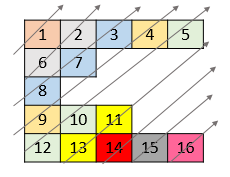Given a list of lists of integers, nums, return all elements of nums in diagonal order as shown in the below images.
Example 1:

Input: nums = [[1,2,3],[4,5,6],[7,8,9]] Output: [1,4,2,7,5,3,8,6,9]
Example 2:

Input: nums = [[1,2,3,4,5],[6,7],[8],[9,10,11],[12,13,14,15,16]] Output: [1,6,2,8,7,3,9,4,12,10,5,13,11,14,15,16]
Example 3:
Input: nums = [[1,2,3],[4],[5,6,7],[8],[9,10,11]] Output: [1,4,2,5,3,8,6,9,7,10,11]
Example 4:
Input: nums = [[1,2,3,4,5,6]] Output: [1,2,3,4,5,6]
Constraints:
1 <= nums.length <= 10^51 <= nums[i].length <= 10^51 <= nums[i][j] <= 10^9- There at most
10^5elements innums.
如上图所示,给定一个残缺矩阵,要求遍历每个对角线,输出所有元素的值。
朴素解法会TLE,特别是如果有某一行或某一列比其他行列长特别多的情况。
提示解法:观察规律发现,处于同一对角线的元素的行列下标之和相等。所以我们可以把所有元素的行列下标进行排序,如果下标和相等,则处于同一对角线,按行下标从大到小排序;如果下标和不相等,则按下标和从小到大排序。完整代码如下:
bool cmp(const pair<int, int> &p1, const pair<int, int> &p2) {
int sum1 = p1.first + p1.second, sum2 = p2.first + p2.second;
if (sum1 == sum2) {
return p1.first > p2.first;
}
else {
return sum1 < sum2;
}
}
class Solution {
public:
vector<int> findDiagonalOrder(vector<vector<int>>& nums) {
vector<pair<int, int>> idxs;
for (int i = 0; i < nums.size(); ++i) {
for (int j = 0; j < nums[i].size(); ++j) {
idxs.push_back(make_pair(i, j));
}
}
sort(idxs.begin(), idxs.end(), cmp);
vector<int> ans;
for (int i = 0; i < idxs.size(); ++i) {
ans.push_back(nums[idxs[i].first][idxs[i].second]);
}
return ans;
}
};本代码提交AC,用时500MS。